Recombinant Hormone Market Size
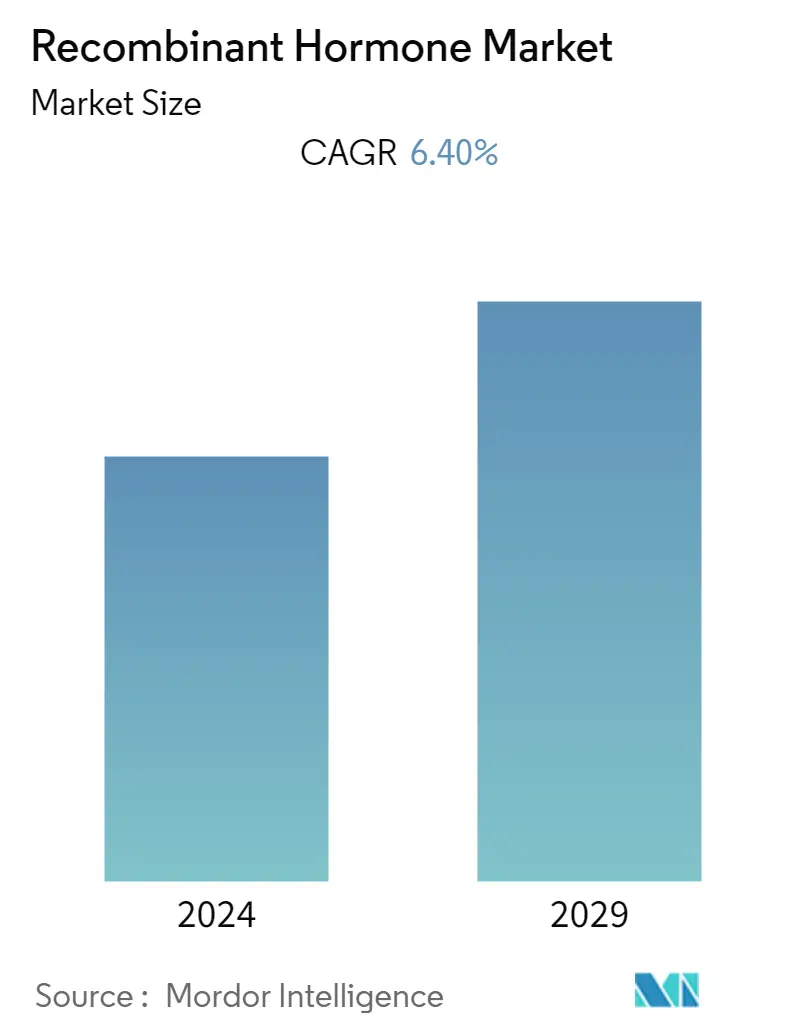
| Study Period | 2019 - 2029 |
| Base Year For Estimation | 2023 |
| Forecast Data Period | 2024 - 2029 |
| CAGR | 6.40 % |
| Fastest Growing Market | Asia-Pacific |
| Largest Market | North America |
Major Players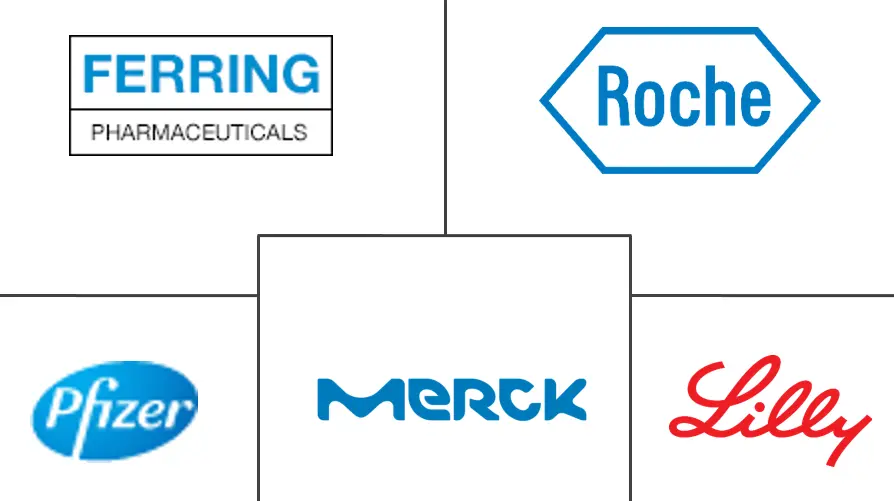
*Disclaimer: Major Players sorted in no particular order |
Recombinant Hormone Market Analysis
The recombinant hormone market is expected to register a CAGR of 6.4% over the forecast period.
COVID-19 is expected to drive the growth of the recombinant hormone market. The increased risk for diseases like diabetes during the COVID-19 outbreak is expected to drive the demand for recombinant hormones like insulin in the market. For instance, in February 2022, Massachusetts General Hospital stated that, in COVID-19 hospital admissions worldwide, high rates of newly diagnosed Diabetic Mellitus (NDDM) had been recorded. This high rate of new diabetes cases increases the need for recombinant insulin. Thus, the outbreak of COVID-19 is expected to drive the growth of the recombinant hormone market during the pandemic period. However, as the pandemic has been subsidized, the market is expected to project stable growth due to the application of recombinant hormones in different diseases.
The major factors that drive the market include the increasing or high burden of growth disorders and diabetes and technological advancements in the development of recombinant hormonal therapies. For instance, as per the IDF Diabetes Atlas 2021, the number of adults that are living with diabetes worldwide is estimated to be 537 million. This high burden of diabetes increases the need for advanced treatment using recombinant insulin and is expected to drive the market over the study period.
Furthermore, the new research studies on the recombinant hormones for accessing the safety profile increase the widespread of the products that help boost the market's growth. For instance, as per the study report published by Frontiers in Endocrinology in July 2022, PEGylated recombinant human growth hormone, Jintrolong, exhibited good long-term safety in cynomolgus monkeys and human pediatric growth hormone deficiency patients. The better safety profile of the product increases the usage of the drug and is expected to propel the market over the forecast period.
Hence, the factors like the high burden of diabetes and new research studies on recombinant hormones are expected to increase the usage of recombinant hormones and likely boost the market growth. However, adverse effects associated with recombinant hormonal therapies and stringent regulatory processes are the factors that hinder market growth over the forecast period.
Recombinant Hormone Market Trends
This section covers the major market trends shaping the Recombinant Hormone Market according to our research experts:
Insulin Segment is Expected to Hold a Major Share in the Market Over the Forecast Period
The insulin hormone is secreted by the beta cells of Islets of Langerhans of the pancreas, which catabolizes glucose in the blood. Insulin helps to keep blood sugar levels from getting too high (hyperglycemia) or too low (hypoglycemia). The increasing cases of diabetes, along with new developments and product launches, increase the usage of insulin, which is expected to boost the market over the forecast period.
According to the IDF Diabetes Atlas 2021, the total number of adults with diabetes worldwide is estimated to be 643 million in 2030, which is expected to rise to 784 million by 2045. Hence, the increasing burden of diabetes is expected to have a significant impact on the recombinant insulin usage that drives the market over the forecast period.
Furthermore, new product developments and launches in the market segment are expected to boost the market's growth. For instance, in November 2021, Viatris Inc. and Biocon Biologics Ltd. launched the interchangeable biosimilars SEMGLEE (insulin glargine-yfgn), a recombinant human long-acting insulin analog, in the United States to help control high blood sugar in adult and pediatric patients with type 1 diabetes and adults with type 2 diabetes. Hence, the new product launches, along with the high burden of hormonal diseases, help to expand the product portfolio of the market players, which is expected to propel the market growth over the forecast period.
Thus, owing to the rising burden of diabetes and the launch of new products, the insulin segment of the market is expected to have considerable growth over the forecast period.
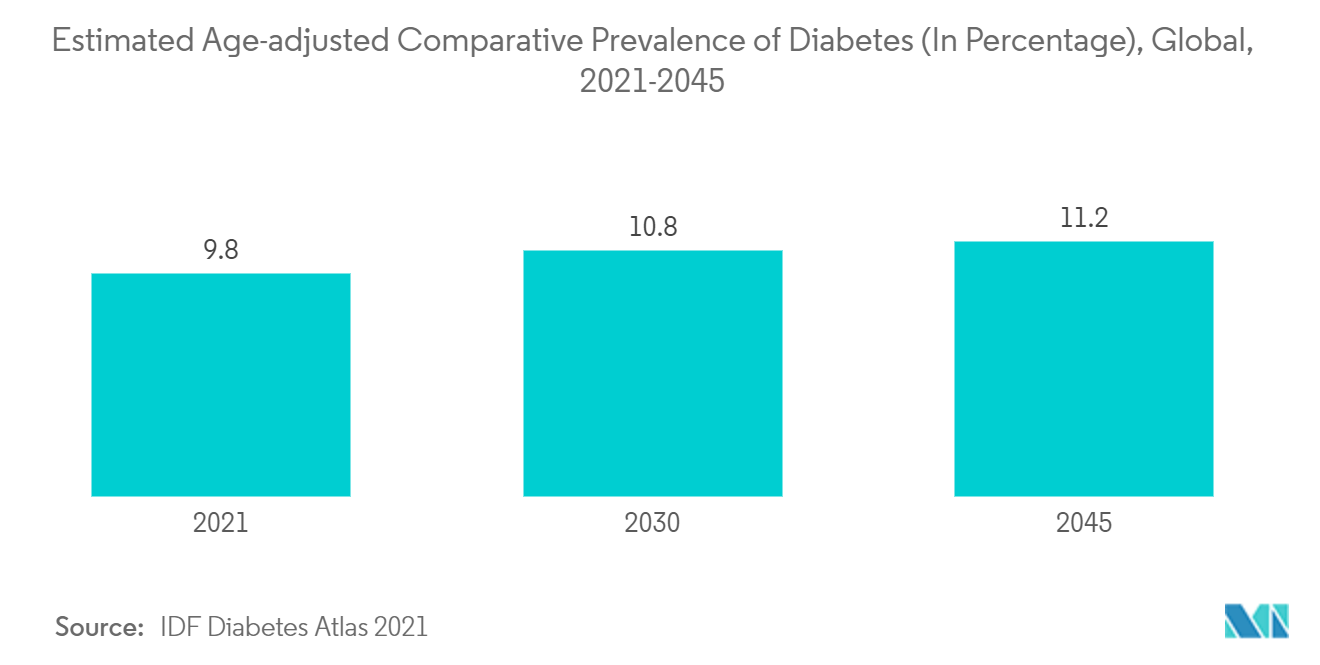
North America is Expected to Hold a Significant Share in the Market Over the Forecast Period.
North America is expected to hold a major market share in the recombinant hormone market owing to the increasing expenditure on research and increasing incidence of hormonal disorders. In addition to the above-mentioned factors, the presence of advanced healthcare infrastructure and several major market players in the region is expected to have significant growth in the market over the forecast period.
According to the NIH RCDC 2022, the funding for the research on diabetes in the United States is estimated to be USD 1,124 million in 2021, which is expected to rise to USD 1,209 million by 2023. This research funding involves various categories, which also involve advanced treatment studies like recombinant hormones, and is expected to boost the market over the forecast period. Furthermore, new product developments and launches in the region increase the expansion of applications in the region.
For instance, in October 2021, Ascendis Pharma A/S launched SKYTROFA (lonapegsomatropin-tcgd), its once-weekly treatment for the treatment of pediatric patients one year and older who weigh at least 11.5 kg (25.4 lb) and have growth failure due to inadequate secretion of endogenous growth hormone (GH) in the United States. Similarly, in October 2021, Pfizer Canada ULC received approval for its next-generation long-acting growth hormone injection, PrNGENLA (somatrogon), from Health Canada. NGENLA is a once-weekly long-acting recombinant human growth hormone for the long-term treatment of pediatric patients who have growth failure due to an inadequate secretion of endogenous growth hormone (growth hormone deficiency or GHD). Thus, the new product launches in the region help increase the widespread applications, which are expected to boost the market over the forecast period.
Therefore, all the aforementioned factors, like the high prevalence of hormonal diseases and the latest company activities like product approvals and launches, are expected to increase the usage of recombinant hormone products and likely propel the market to grow over the forecast period.
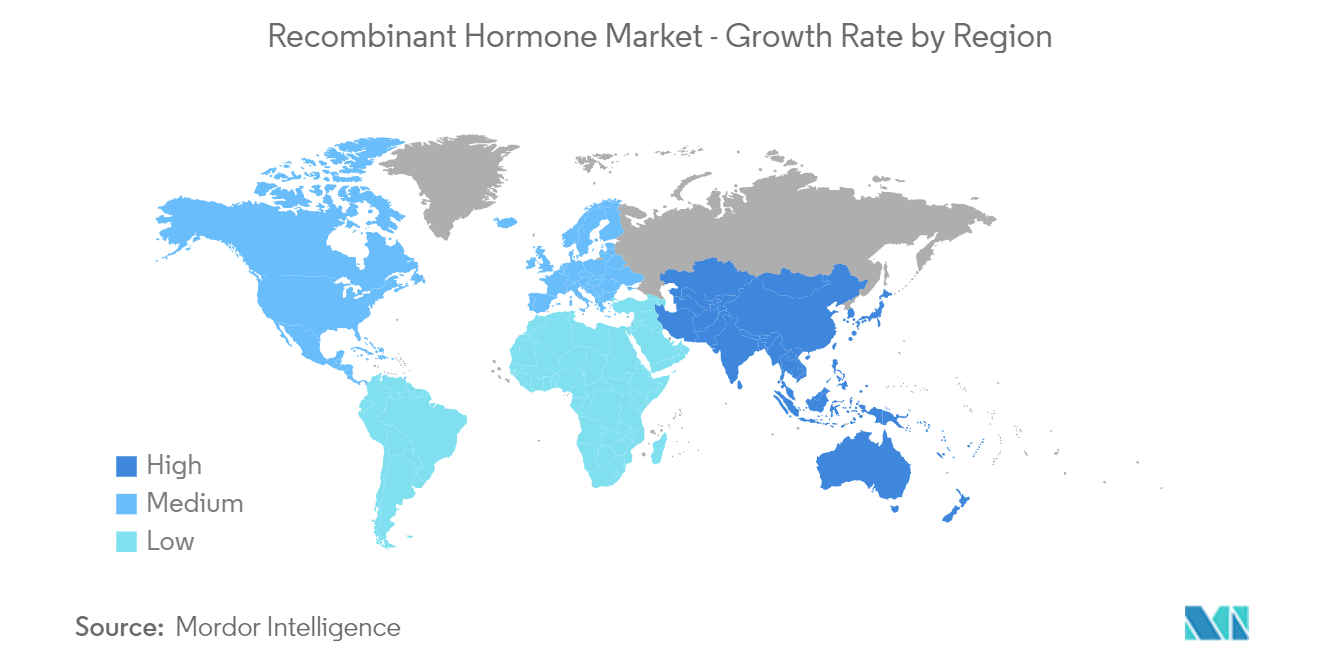
Recombinant Hormone Industry Overview
The recombinant hormone market is consolidated and consists of a few major players. In terms of market share, a few of the major players are currently dominating the market. Collaborations and mergers over the next coming years to share technology and increasing investments for innovation in the field are expected to be observed. Some of the major market players include Eli Lilly and Company, Ferring Pharmaceuticals, Hoffmann La Roche Ltd (Genentech, Inc), Merck & Co Inc, Pfizer Inc, Novo Nordisk A/S, Novartis AG, Ipsen Pharma, LG Life Sciences and Teva Pharmaceutical Industries.
Recombinant Hormone Market Leaders
-
Eli Lilly and Company
-
Ferring Pharmaceuticals
-
F.Hoffmann-La Roche Ltd (Genentech, Inc)
-
Merck & Co Inc (Merck KGaA)
-
Pfizer Inc
*Disclaimer: Major Players sorted in no particular order
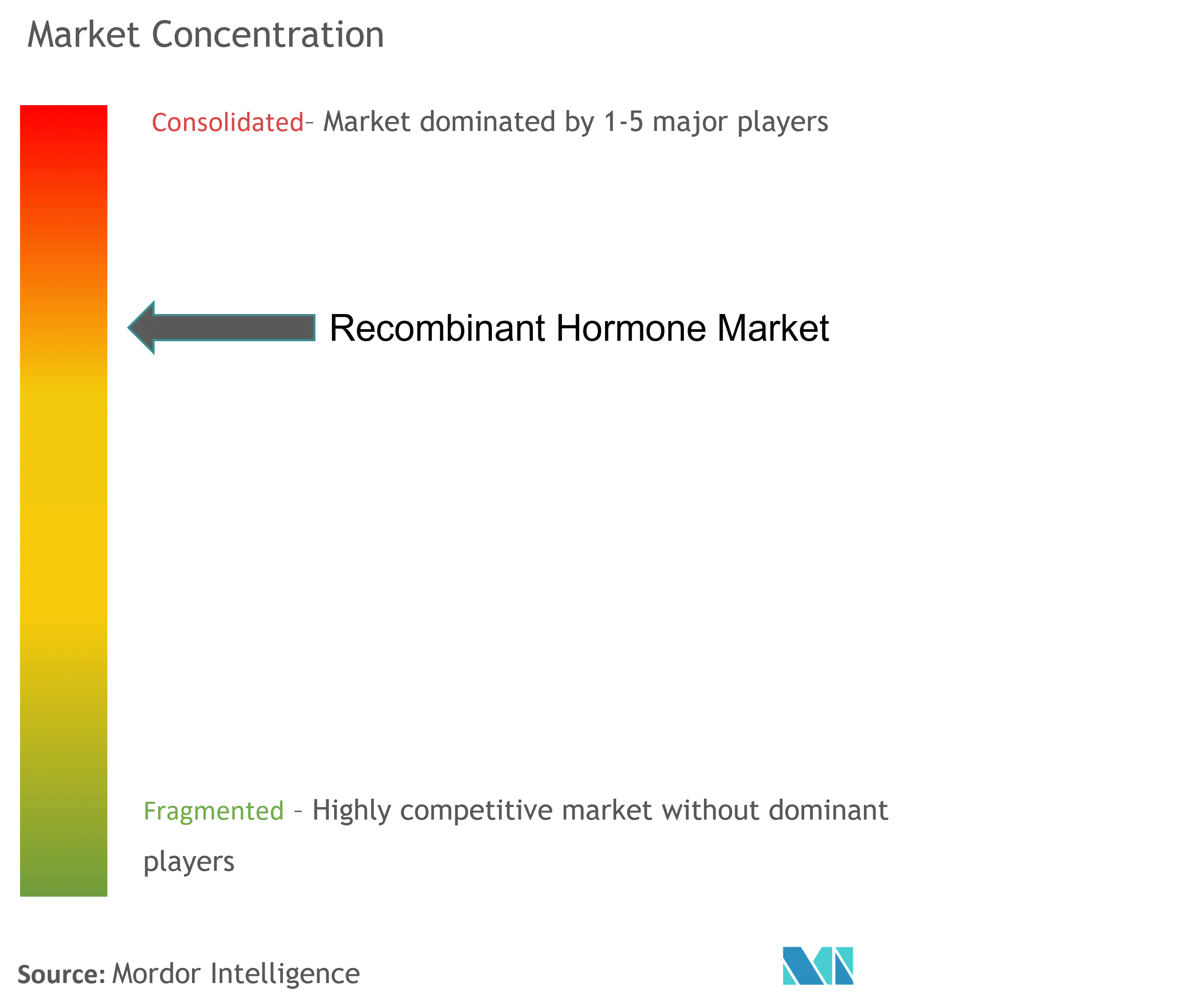
Recombinant Hormone Market News
- November 2022: Biocon Ltd acquired the global biosimilars business of its partner Viatris Inc. With the closing of the deal, Biocon Biologics has full ownership of its collaboration asset biosimilar Insulin Glargine 300U.
- February 2022: Pfizer Inc. and OPKO Health, Inc. received marketing authorization from the European Commission for the next-generation long-acting recombinant human growth hormone NGENLA (somatrogon), a once-weekly injection to treat children and adolescents from 3 years of age with growth disturbance due to insufficient secretion of growth hormone.
Recombinant Hormone Market Report - Table of Contents
1. INTRODUCTION
1.1 Study Assumptions and Market Definition
1.2 Scope of the Study
2. RESEARCH METHODOLOGY
3. EXECUTIVE SUMMARY
4. MARKET DYNAMICS
4.1 Market Overview
4.2 Market Drivers
4.2.1 Increasing Incidence of Growth Disorders and Diabetes
4.2.2 Technological Advancements in Development of Recombinant Hormonal Therapies
4.3 Market Restraints
4.3.1 Adverse Effects Associated with Recombinant Hormonal Therapies
4.3.2 Stringent Regulatory Processes
4.4 Porter's Five Forces Analysis
4.4.1 Threat of New Entrants
4.4.2 Bargaining Power of Buyers/Consumers
4.4.3 Bargaining Power of Suppliers
4.4.4 Threat of Substitute Products
4.4.5 Intensity of Competitive Rivalry
5. MARKET SEGMENTATION (Market Size by Value - USD million)
5.1 By Product Type
5.1.1 Growth Hormone
5.1.2 Insulin
5.1.3 Follicle-stimulating Hormone
5.1.4 Other Products
5.2 Geography
5.2.1 North America
5.2.1.1 United States
5.2.1.2 Canada
5.2.1.3 Mexico
5.2.2 Europe
5.2.2.1 Germany
5.2.2.2 United Kingdom
5.2.2.3 France
5.2.2.4 Italy
5.2.2.5 Spain
5.2.2.6 Rest of Europe
5.2.3 Asia-Pacific
5.2.3.1 China
5.2.3.2 Japan
5.2.3.3 India
5.2.3.4 Australia
5.2.3.5 South Korea
5.2.3.6 Rest of Asia-Pacific
5.2.4 Middle East and Africa
5.2.4.1 GCC
5.2.4.2 South Africa
5.2.4.3 Rest of Middle East and Africa
5.2.5 South America
5.2.5.1 Brazil
5.2.5.2 Argentina
5.2.5.3 Rest of South America
6. COMPETITIVE LANDSCAPE
6.1 Company Profiles
6.1.1 Eli Lilly and Company
6.1.2 Ferring Pharmaceuticals
6.1.3 F. Hoffmann-La Roche Ltd (Genentech, Inc)
6.1.4 Merck & Co Inc
6.1.5 Pfizer Inc
6.1.6 Novo Nordisk A/S
6.1.7 Novartis AG
6.1.8 Ipsen Pharma
6.1.9 LG Life Sciences
6.1.10 Teva Pharmaceutical Industries
6.1.11 Bio-Rad Laboratories, Inc
6.1.12 Biocon
- *List Not Exhaustive
7. MARKET OPPORTUNITIES AND FUTURE TRENDS
Recombinant Hormone Industry Segmentation
The recombinant hormone is the hormone made in a laboratory using recombinant technology, which is used for therapeutic purposes. The Recombinant Hormone Market is segmented by Product Type (Growth Hormone, Insulin, Follicle-stimulating Hormone, Other Products) and Geography (North America, Europe, Asia-Pacific, Middle East and Africa, and South America). The market report also covers the estimated market sizes and trends for 17 countries across major regions globally. The report offers the value (in USD million) for the above segments.
| By Product Type | |
| Growth Hormone | |
| Insulin | |
| Follicle-stimulating Hormone | |
| Other Products |
| Geography | ||||||||
| ||||||||
| ||||||||
| ||||||||
| ||||||||
|
Recombinant Hormone Market Research FAQs
What is the current Recombinant Hormone Market size?
The Recombinant Hormone Market is projected to register a CAGR of 6.40% during the forecast period (2024-2029)
Who are the key players in Recombinant Hormone Market?
Eli Lilly and Company, Ferring Pharmaceuticals, F.Hoffmann-La Roche Ltd (Genentech, Inc), Merck & Co Inc (Merck KGaA) and Pfizer Inc are the major companies operating in the Recombinant Hormone Market.
Which is the fastest growing region in Recombinant Hormone Market?
Asia-Pacific is estimated to grow at the highest CAGR over the forecast period (2024-2029).
Which region has the biggest share in Recombinant Hormone Market?
In 2024, the North America accounts for the largest market share in Recombinant Hormone Market.
What years does this Recombinant Hormone Market cover?
The report covers the Recombinant Hormone Market historical market size for years: 2019, 2020, 2021, 2022 and 2023. The report also forecasts the Recombinant Hormone Market size for years: 2024, 2025, 2026, 2027, 2028 and 2029.
Recombinant Hormone Industry Report
Statistics for the 2024 Recombinant Hormone market share, size and revenue growth rate, created by Mordor Intelligence™ Industry Reports. Recombinant Hormone analysis includes a market forecast outlook to 2029 and historical overview. Get a sample of this industry analysis as a free report PDF download.



